The Maya are probably the best-known of the classical civilizations of Mesoamerica.
Originating in the Yucatan around 2600 B.C., they rose to prominence around A.D. 250 in present-day southern Mexico, Guatemala, western Honduras, El Salvador, and northern Belize.
Building on the inherited inventions and ideas of earlier civilizations such as the Olmec, the Mayans developed astronomy, calendrical systems and hieroglyphic writing. The Mayans were noted as well for elaborate and highly decorated ceremonial architecture, including temple-pyramids, palaces and observatories, all built without metal tools. They were also skilled farmers, clearing large sections of tropical rain forest and, where groundwater was scarce, building sizeable underground reservoirs for the storage of rainwater. The Mayans were equally skilled as weavers and potters, and cleared routes through jungles and swamps to foster extensive trade networks with distant peoples.
Many people believe that the ancestors of the Mayans crossed the Bering Strait at least 20,000 years ago. They were nomadic hunter-gatherers. Evidence of settled habitation in Mexico is found in the Archaic period 5000-1500 BC - corn cultivation, basic pottery and stone tools.
The first true civilization was established with the rise of the Olmecs in the Pre-Classic period 1500 BC -300 AD. The Olmecs settled on the Gulf Coast, and little is known about them.
The Mayans are regarded as the inventors of many aspects of Meso-American cultures including the first calendar and hieroglyphic writing in the Western hemisphere. Archeologists have not settled the relationship between the Olmecs and the Mayans, and it is a mystery whether the Mayans were their descendants, trading partners, or had another relationship. It is agreed that the Mayans developed a complex calendar and the most elaborate form of hieroglyphics in America, both based on the Olmec's versions.
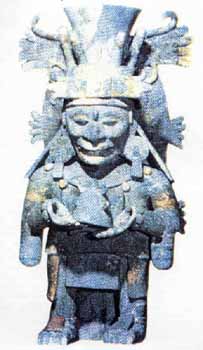
Mayans seem to have entered Yucatan from the west. As usual with ancient nations, it is difficult in the beginning to separate myth from history, their earliest mentioned leader and deified hero, Itzamná, being considered to be simply a sun-god common to the Mayan civilization. He is represented as having led the first migration from the Far East, beyond the ocean, along a pathway miraculously opened through the waters.
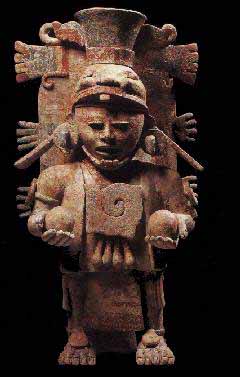
The second migration, which seems to have been historic, was led from the west by Kukulcan, a miraculous priest and teacher, who became the founder of the Mayan kingdom and civilization. Fairly good authority, based upon study of the Mayans chronicles and calendar, places this beginning near the close of the second century of the Christian Era.
Under Kukulcan the people were divided into four tribes, ruled by as many kingly families: the Cocom, Tutul-xiu, Itzá and Chele.
To the first family belonged Kukulcan himself, who established his residence at Mayanspan, which thus became the capital of the whole nation. The Tutul-xiu held vassal rule at Uxmal, the Itzá at Chichen-Itzá, and the Chelé at Izamal.
To the Chele was appointed the hereditary high priesthood, and their city became the sacred city of the Mayans. Each provincial king was obliged to spend a part of each year with the monarch at Mayapan. This condition continued down to about the eleventh century, when, as the result of a successful revolt of the provincial kings, Mayapan was destroyed, and the supreme rule passed to the Tutul-xiu at Uxmal.
Later on Mayapan was rebuilt and was again the capital of the nation until about the middle of the fifteenth century, when, in consequence of a general revolt against the reigning dynasty, it was finally destroyed, and the monarchy was split up into a number of independent petty states, of which eighteen existed on the peninsula at the arrival of the Spaniards.
In consequence of this civil war a part of the Itzá emigrated south to Lake Petén, in Guatemala, where they established a kingdom with their capital and sacred city of Flores Island in the lake.
Mayan Classic Period - 300-900 AD
Most artistic and cultural achievement came about during the Classic period 300 - 900 AD. The Mayans developed a complex, hierarchical society divided into classes and professions. Centralized governments, headed by a king, ruled territories with clearly defined boundaries. These borders changed as the various states lost and gained control over territory. Mayansn centers flourished in Mexico, Guatemala, Belize, Honduras, and El Salvador. The major cities of the Classic period were Tikal (Guatemala), Palenque and Yaxchilán (Chiapas, Mexico), Copán and Quirigua (Honduras). For most of this period, the majority of the Mayans population lived in the central lowlands of Mexico and Belize.
The Northern Yucatan (where present day Cancun is located) was sparsely populated for most of the Classic period with only a few cities such as Dzibilchaltún (near Mérida) and Xpuhil, Becán and Chicanná (near Chetumal). During the 9th century the population centers of the central lowlands declined significantly. This decline was very rapid and is attributed to famine, drought, breakdowns in trade, and political fragmentation. Fragmentation from large states into smaller city-states focused resources on rivalries between cities including not just wars, but competitions of architecture and art between rival cities. As the cities in the lowlands declined, urban centers sprung up in the Northern Yucatán, including Uxmal (near Mérida).
Anthropologists used to contrast the "peaceful" Mayans with the bloodthirsty Aztecs of central Mexico. Although human sacrifice was not as important to the Mayans as to the Aztec, blood sacrifice played a major role in their religion. Individuals offered up their blood, but not necessarily their lives, to the gods through painful methods using sharp instruments such as sting-ray spines or performed ritualistic self mutilation. It is probable that people of all classes shed their blood during religious rites. The king's blood sacrifice was the most valuable and took place more frequently. The Mayans were warlike and raided their neighbors for land, citizens, and captives. Some captives were subjected to the double sacrifice where the victims heart was torn out for the sun and head cut off to pour blood out for the earth.
The Mayansn civilization was the height of pre-Columbian culture. They made significant discoveries in science, including the use of the zero in mathematics. Their writing was the only in America capable of expressing all types of thought. Glyphs either represent syllables or whole concepts and were written on long strips of paper or carved and painted on stone. They are arranged to be red from left to right and top to bottom in pairs of columns. The Mayansn calendar begins around 3114 BC, before Mayans culture existed, and could measure time well into the future. They wrote detailed histories and used their calendar to predict the future and astrological events. Fray Diego de Landa, second bishop of the Yucatán ordered a mass destruction of Mayansn books in 1562 and only three survived.
Post Classic Period - 1000 - 1500 AD - Growth and Ruin
After the Classic period, the Mayans migrated to the Yucatán peninsula. There they developed their own character, although their accomplishments and artwork are not considered as impressive as the Classic Mayans. Most of the ruins you can see South of Cancun are from this time period and are definitely worth a visit.
Chichen Itza (near Valladolid), Uxmal (near Merida) and Mayanspán (west of Chichen Itza) were the three most important cities during the Post Classic period. They lived in relative peace from around 1000 - 1100 AD when Mayanspán overthrew the confederation and ruled for over 200 years. In 1441 the Mayans who had previously ruled Uxmal destroyed the city of Mayanspán and founded a new city at Mani. Wars were fought between rival Mayansn groups over the territory until the region was conquered by the Spanish.
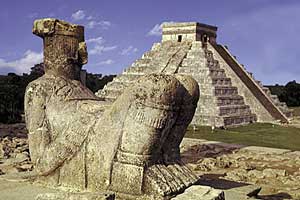
Chichen Itza was first populated between 500 and 900 AD by Mayans and for some reason abandoned around 900, the city was then resettled 100 years later and subsequently invaded by Toltecs from the North. There are numerous reliefs of both Mayan gods including Chac and the Toltec gods including Quetzalcoatl.
For some reason the city was abandoned around 1300. If the Spanish did not make it a policy to kill all of the Mayan priests and burn books when they arrived in Mexico, we would all have a few more answers.
Post Columbian Period - Conquest and Rebellion (1500 AD)
On his second voyage Columbus heard of Yucatan as a distant country of clothed men. On his fifth voyage (1503-04) he encountered, south-west of Cuba, a canoe-load of Indians with cotton clothing for barter, who said that they came from the ancient Mayan civilization.
In 1506 Pinzon sighted the coast, and in 1511 twenty men under Valdivia were wrecked on the shores of the sacred island of Cozumel, several being captured and sacrificed to the idols.
The Spanish colonization of the islands of Hispaniola and Cuba allowed them to launch exploratory forays around the Caribbean. Córdoba discovered Isla Mujeres in 1517 and sailed down the Yucatán Gulf coast to were he suffered heavy losses at the hands of the Mayans. Cortés set sail in 1519 and landed in Veracruz. He conquered the Aztecs in a year, but it took another 20 years to conquer the Yucatán. In 1526 Francisco Montejo set out to conquer the Yucatan.
The Mayans fought the invaders for 20 years, but eventually succumbed. The Mayans were slaughtered during the battles with the Spaniards, but imported European diseases decimated the population. The Mayans were moved into villages and paid heavy taxes to the Spanish government. There were periodic rebellions against the Spanish.
The Yucatan Mayans launched a major uprising starting in July 1847 called the Caste War. The Spanish were distracted by the war between the US and Mexico and nearly lost the peninsula. The Mayans attacked Spanish villages armed by English settlers from Belize and with guns distributed to defend Yucatán's secession in 1846. They regained 90% of their lands and held all of the Yucatán except Campeche and Merida.
At the height of their revolutionary success, the Mayans inexplicably withdrew to their villages - reputedly to plant corn for the season. The war with the US ended in 1848 and reinforcements were sent to the Yucatán, where they drove the Mayans back to Chan Santa Cruz. The Mayans resisted for several years, but disease and weapons shortages forced them to surrender in 1901.
After 50 years of independence, their lands became federal territory. In reality, the Southern and Eastern half of the peninsula remained a virtual no man's land to outsiders where the Mayans lived almost as they pleased. This changed in the late 1960s when coastal development began.
Father Alonso Gonzalez, who accompanied this expedition, found opportunity at one landing to explore a temple, and bring off some of the sacred images and gold ornaments. In 1518 a strong expedition under Juan de Grijalva, from Cuba, landed near Cozumel and took formal possession for Spain.
For Father Juan Diaz, who on this occasion celebrated Mass upon the summit of one of the heathen temples, the honour is also claimed of having afterwards been the first to celebrate mass in the City of Mexico.
Near Cozumel, also, was rescued the young monk Aguilar, one of the two survivors of Valdivia's party, who, though naked to the breech-cloth, still carried his Breviary in a pouch. Proceeding northwards, Grijaba made the entire circuit of the peninsula before returning, having had another desperate engagement with the Mayans near Campeche.
After the conquest of Mexico in 1521, Francisco de Montejo, under commission as Governor of Yucatan, landed (1527) to effect the conquest of the country, but met with such desperate resistance that after eight years of incessant fighting every Spaniard had been driven out. In 1540, after two more years of the same desperate warfare, his son Francisco established the first Spanish settlement at Campeche.
In the next year, in a bloody battle at Tihoo, he completely broke the power of Mayans resistance, and a few months later (Jan., 1542) founded on the site of the ruined city the new capital, Mérida. In 1546, however, there was a general revolt, and it was not until a year later that the conquest was assured.
In the original commission to Montejo it had been expressly stipulated that missionaries should accompany all his expeditions. This, however, he had neglected to attend to, and in 1531 (or 1534), by special order, Father Jacobo de Testera and four others were sent to join the Spanish camp near Campeche.
They met a kindly welcome from the Indians, who came with their children to be instructed, and thus the conquest of the country might have been effected through spiritual agencies but for the outrages committed by a band of Spanish outlaws, in consequence of which the priests were forced to withdraw.
In 1537 five more missionaries arrived and met the same willing reception, remaining about two years in spite of the war still in progress. About 1545 a large number of missionaries were sent over from Spain. Several of these - apparently nine, all Franciscans - under the direction of Father Luis de Villalpando, were assigned to Yucatan.
Landing at Campeche, the governor explained their purpose to the chiefs, the convent of St. Francis was dedicated on its present site, and translations were begun into the native language. The first baptized convert was the chief of Campeche, who learned Spanish and thereafter acted as interpreter for the priests.
Here, as elsewhere, the missionaries were the champions of the rights of the Indians. In consequence of their repeated protests a royal edict was issued, in 1549, prohibiting Indian slavery in the province, while promising compensation to the slave owners.
As in other cases, local opposition defeated the purpose of this law; but the agitation went on, and in 1551 another royal edict liberated 150,000 male Indian slaves, with their families, throughout Mexico.
In 1557 and 1558 the Crown intervened to restrain the tyranny of the native chiefs. Within a very short time Father Villalpando had at his mission station at Mérida over a thousand converts, including several chiefs.
He himself, with Father Malchior de Benavente, then set out, barefoot, for the city of Mani in the mountains farther south, where their success was so great that two thousand converts were soon engaged in building them a church and dwelling. All went well until they began to plead with the chiefs to release their vassals from certain hard conditions, when the chiefs resolved to burn them at the altar.
On the appointed night the chiefs and their retainers approached the church with this design, but were awed from their purpose on finding the two priests, who had been warned by an Indian boy, calmly praying before the crucifix. After remaining all night in prayer, the fathers were fortunately rescued by a Spanish detachment which, almost miraculously, chanced to pass that way.
Twenty-seven of the conspirators were afterwards seized and condemned to death, but were all saved by the interposition of Villalpando.
In 1548-49 other missionaries arrived from Spain, Villalpando was made custodian of the province, and a convent was erected near the site of his chapel at Mani. The Yucatan field having been assigned to the Franciscans, all the missionary work among the Mayans was done by priests of that order.
In 1561 Yucatan was made a diocese with its see at Mérida.
1562 - the famous Diego de Landa, Franciscan provincial, and afterwards bishop (1573-79), becoming aware that the natives throughout the peninsula still secretly cherished their ancient rites, instituted an investigation, which he conducted with such cruelties of torture and death that the proceedings were stopped by order of Bishop Toral Franciscan provincial of Mexico, immediately upon his arrival, during the same summer, to occupy the See of Mérida.
Before this could be done, however, there had been destroyed, as is asserted, two million sacred images and hundreds of hieroglyphic manuscripts - practically the whole of the voluminous native Mayans literature. As late as 1586 a royal edict was issued for the suppression of idolatry.
In 1575-77 a terrible visitation of a mysterious disease, called matlalzahuatl, which attacked only the Indians, swept over Southern Mexico and Yucatan, destroying, as was estimated, over two million lives. This was its fourth appearance since the conquest.
At its close it was estimated that the whole Indian population of Mexico had been reduced to about 1,700,000 souls. In 1583 and 1597 there were local revolts under chiefs of the ancient Cocom royal family. By this latter date it was estimated that the native population of Mexico had declined by three-fourths since the discovery, through massacre, famine, disease, and oppression.
Up to 1593 over 150 Franciscan monks had been engaged in missionary work in Yucatan.
The Mayans history of the seventeenth century is chiefly one of revolutions, viz., 1610-33, 1636-44, 1653, 1669, 1670, and about 1675.
Of all these, that of 1636-44 was the most extensive and serious, resulting in a temporary revival of the old heathen rites. In 1697 the island capital of the Itzá, in Lake Petén, Guatemala, was stormed by Governor Martín de Ursua, and with it fell the last stronghold of the independent Mayans. Here, also, the manuscripts discovered were destroyed.
In 1728 Bishop Juan Gomez Parada died, beloved by the Indians for the laws which he had procured mitigating the harshness of their servitude. The reimposition of the former hard conditions brought about another revolt in 1761, led by the chief Jacinto Canek, and ending, as usual, in the defeat of the Indians, the destruction of their chief stronghold, and the death of their leader under horrible torture.
In 1847, taking advantage of the Government's difficulties with the United States, and urged on by their "unappeasable hatred toward their ruler from the earliest time of the Spanish conquest", the Mayans again broke out in general rebellion, with the declared purpose of driving all the whites, half-breeds and negroes from the peninsula, in which they were so far successful that all the fugitives who escaped the wholesale massacres fled to the coast, whence most of them were taken off by ships from Cuba. Arms and ammunition for the rising were freely supplied to the Indians by the British traders of Belize.
In 1851 the rebel Mayans established their headquarters at Chan-Santa-Cruz in the eastern part of the peninsula. In 1853 it seemed as if a temporary understanding had been reached, but next year hostilities began again. Two expeditions against the Mayans stronghold were repulsed, Valladolid was besieged by the Indians, Yecax taken, and more than two thousand whites massacred.
In 1860 the Mexican Colonel Acereto, with 3,000 men occupied Chan-Santa-Cruz, but was finally compelled to retire with the loss of 1,500 men killed, and to abandon his wounded - who were all butchered - as well as his artillery and supplies and all but a few hundred stand of small arms.
The Indians burned and ravaged in every direction, nineteen flourishing towns being entirely wiped out, and the population in three districts being reduced from 97,000 to 35,000. The war of extermination continued, with savage atrocities, through 1864, when it gradually wore itself out, leaving the Indians still unsubdued and well supplied with arms and munitions of war from Belize.
1868 - fighting broke out again in resistance to the Juarez government.
1871 - a Mexican force again occupied Chan-Santa-Cruz, but retired without producing any permanent result.
1901 - after long preparation, a strong Mexican force invaded the territory of the independent Mayans both by land and sea, stormed Chan-Santa-Cruz and, after determined resistance, drove the defenders into the swamps.
1910 - Mexican troops put down a serious rising in the northern part of the peninsula.
Modern Mayans
Mayans are around today
In spite of the invasion of foreign tourism, Mayan culture has remained amazingly intact. Many of the Yucatan Mayans whose ancestors were hunters, chicle farmers and fisherman now work in hotels and other tourist related businesses. More than 350,000 Mayans living in the Yucatan speak Yukatek Mayans and most speak Spanish as a second language, primarily learned in school.
The clothing worn is as it was in the past. It is relatively easy to determine the village in which the clothing was made by the the type of embroidery, color, design and shape.
Mayans women can be seen wearing huipils, simple cotton dresses decorated with embroidery. The designs in their embroidery and weaving can be traced back to pre-Columbian times.
Although Mayans in other parts of Central America choose to limit contact with outside influences, Mayans working in the tourist industry are generally open to conversation with polite strangers and if asked will teach you a Mayan phrase or two.
In the Indian communities, as it was with their Mayan ancestors, the basic staple diet is corn.
Mayan dialects of Qhuche, Cakchiquel, Kekchi, and Mam are still spoken today, although the majority of Indians also speak Spanish.
References:
Catholic Encyclopedia
Maya Civilization Wikipedia
The Maya were resourceful in harnessing energy, creating amazingly sophisticated works of art and engineering and sustaining a civilization for approximately 1,500 years. It has been shown that the Maya had attributes of the supernatural, and were masters of their environment. Their secret wisdom remains unknown, some people attributing it to extraterrestrials races, whose space ships are seen to this very day in Central and South America.
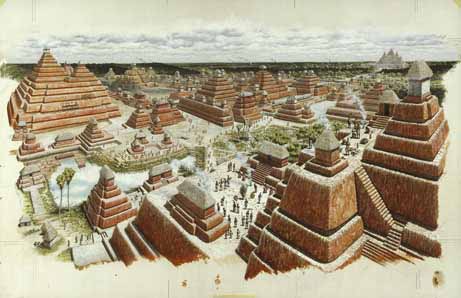
As with ancient Egyptian Pharaohs, Mayan rulers filled vast cities with sky high pyramids, ornate and lavish palaces personifying the power of the great kings and their connections to the gods, and astronomical observatories which helped them created their calendars and plan their lives.
The cause of the Mayan collapse came over decades with no one quite sure what happened. There is no one single explanation for this implosion, but some scholars seem to believe that environmental catastropy lead to a full blown meltdown - lack of food and polluted water which produced malnutrition and disease.
As with all civilizations, we discover that their Gods - like those some people worship today our Gods - did not help - as they do not exist - only our own consciousness to guide us in the wastelands of realities.
Mayan archaeology is coming into it's Golden Age with the help of satellite imagery and photography. There are innumerable Mayan cities, temples, and settlements still to be discovered. We have learned that the Maya were an innovative, creative, and majestic people with their own particular taste for violence. The allure of the Maya is coming to the fore. Like the mystique of Egypt, people are drawn to the land of the Maya, each year. There is something they are guided to find, perhaps linked to major planetary grid points that awaken consciousness.
Could other attractions to the land of the Maya include:
- Mayan architecture with its serene palaces and temples
- the intricacies of hieroglyphs and art in a complex writing system
- the astounded comprehension of astronomy and mathematics with a concept of zero unparalleled in antiquity
- is it simply because these remarkable people carved magnificent cities, not just villages and towns, right out of some of the most inhospitable landscape in the entire world? In the rain forest between Honduras and the Yucatan, there are literally thousands of Maya sites that remain untouched. In Palanque alone there are approximately 1,550 buildings that lie unexcavated with endless archaeological treasures yet to be found.
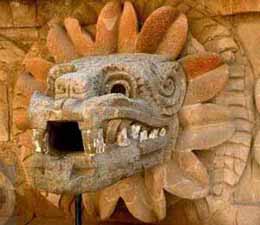
Quetzalcoatl




0 comments:
Post a Comment